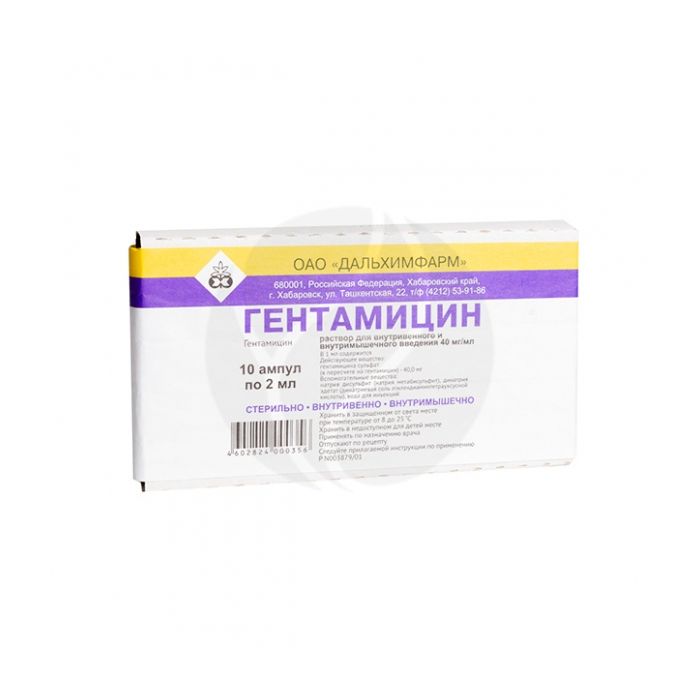Gentamicin solution for injection. 4%, 2 ml No. 10
Expiration Date: 05/2027
Russian Pharmacy name:
Гентамицин раствор д/инъекц. 4%, 2 мл №10
Infectious and inflammatory diseases caused by microorganisms sensitive to gentamicin:
infections of the upper and lower respiratory tract (including bronchitis, pneumonia, pleural empyema),
complicated urogenital infections (pyelonephritis, cystitis, urethritis, prostatitis, gonorrhea, endometritis),
infections of bones and joints (including osteomyelitis),
abdominal infections (peritonitis, pelvioperitonitis),
central nervous system infections (meningitis),
purulent infections of the skin and soft tissues,
wound infection
burn infection.
Set individually, taking into account the severity of the course and localization of the infection, the sensitivity of the pathogen.
When administered intravenously or intramuscularly for adults, a single dose is 1-1.7 mg / kg, a daily dose is 3-5 mg / kg; the frequency of administration is 2-4 times / day. The course of treatment is 7-10 days. Depending on the etiology of the disease, it is possible to use a dose of 120-160 mg 1 time / day for 7-10 days or 240-280 mg once a day. IV infusion is carried out for 1-2 hours.
For children over 2 years of age, the daily dose of gentamicin is 3-5 mg / kg; frequency of administration - 3 times / day. Premature and newborn babies are prescribed in a daily dose of 2-5 mg / kg; frequency of administration - 2 times / day; children under 2 years of age are prescribed the same dose at a frequency of administration 3 times / day.
Patients with impaired renal excretory function require correction of the dosage regimen depending on the CC values.
Maximum daily doses: for adults and children with intravenous or intramuscular administration - 5 mg / kg.
Solution for i / v and i / m administration 1 ml
gentamicin sulfate 40 mg
Hypersensitivity to gentamicin and other antibiotics of the aminoglycoside group,
auditory nerve Hebrew,
severe chronic renal failure with azotemia and uremia,
pregnancy, lactation (breastfeeding),
newborns (up to 1 month), incl. premature babies (due to the high risk of developing ototoxic and nephrotoxic effects).
Carefully
Myasthenia gravis, parkinsonism, botulism (aminoglycosides can cause impaired neuromuscular transmission, which leads to further weakening of skeletal muscles), dehydration, renal failure, old age.
pharmachologic effect
An antibiotic of the aminoglycoside group of a broad spectrum of action. Has a bactericidal effect. Actively penetrating the bacterial cell membrane, it irreversibly binds to the 30S subunit of bacterial ribosomes and, thereby, inhibits the protein synthesis of the pathogen.
Highly active against aerobic gram-negative bacteria: Escherichia coli, Shigella spp., Salmonella spp., Enterobacter spp., Klebsiella spp., Serratia spp., Proteus spp., Pseudomonas aeruginosa, Acinetobacter spp.
It is also active against aerobic gram-positive cocci: Staphylococcus spp. (including those resistant to penicillins and other antibiotics), some strains of Streptococcus spp.
Neisseria meningitidis, Treponema pallidum, some strains of Streptococcus spp., Anaerobic bacteria are resistant to gentamicin.
Pharmacokinetics
After i / m administration, it is rapidly absorbed from the injection site. Cmax is achieved within 30-60 minutes after i / m administration. Plasma protein binding is low (0-10%). It is distributed in the extracellular fluid, in all tissues of the body. Penetrates the placental barrier. Not metabolized. T1 / 2 2-4 hours. 70-95% is excreted in the urine, a small amount in the bile.
Side effect
From the digestive system: nausea, vomiting, increased activity of hepatic transaminases, hyperbilirubinemia.
From the hematopoietic system: anemia, leukopenia, granulocytopenia, thrombocytopenia.
From the urinary system: oliguria, proteinuria, microhematuria, renal failure, tubular necrosis.
From the nervous system: muscle twitching, paresthesia, numbness, epileptic seizures, headache, drowsiness, in children - psychosis.
From the senses: tinnitus, hearing loss, vestibular and labyrinth disorders, irreversible deafness.
Allergic reactions: skin rash, itching, urticaria, fever; rarely - Quincke's edema.
Others: fever, development of superinfection.
Application during pregnancy and lactation
Gentamicin is contraindicated in pregnancy. If necessary, use during lactation should stop breastfeeding.
Application for impaired renal function
Contraindicated in severe renal impairment, uremia. With caution in case of impaired renal function. When using gentamicin, kidney function should be monitored.
Patients with impaired renal excretory function require correction of the dosage regimen depending on the CC values.
In patients with chronic renal failure, it is necessary to take into account the possibility of the resorptive effect of gentamicin when applied externally for a long time on large skin surfaces.
Application in children
Use with caution in newborns (up to 1 month), incl. premature babies.
Use in elderly patients
In elderly patients, use according to the state of renal function.
special instructions
When using gentamicin, the functions of the kidneys, auditory and vestibular apparatus should be monitored.
Patients with infectious and inflammatory diseases of the urinary tract should consume plenty of fluids during treatment.
Drug interactions
Strengthens the muscle relaxant effect of curariform drugs.
Reduces the effectiveness of drugs for the treatment of myasthenia gravis.
Methoxyflurane, polymyxins for parenteral use and other drugs that block neuromuscular transmission (halogenated hydrocarbons as agents for inhalation anesthesia, narcotic analgesics, transfusion of large amounts of blood with citrate preservatives), increase the risk of nephrotoxicity and respiratory depression (due to increased nervous muscle blockade).
With the simultaneous use of gentamicin and 'loop' diuretics (furosemide, ethacrynic acid), the concentration of gentamicin in the blood increases, which increases the risk of developing toxic side reactions.
Toxicity increases with simultaneous use with cisplatin and other oto- and nephrotoxic agents.
Penicillin antibiotics (ampicillin, carbenicillin) enhance the antimicrobial effect by expanding the spectrum of activity.
Parenteral administration of indomethacin increases the risk of developing the toxic effects of aminoglycosides.
Pharmaceutical incompatible with other drugs.

